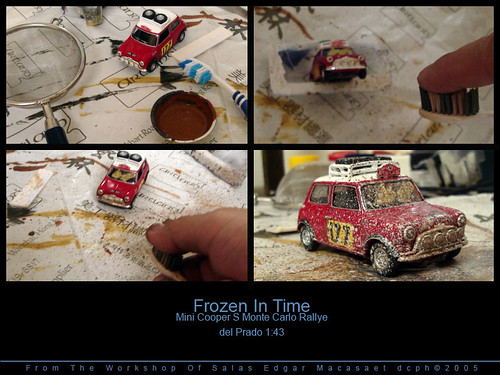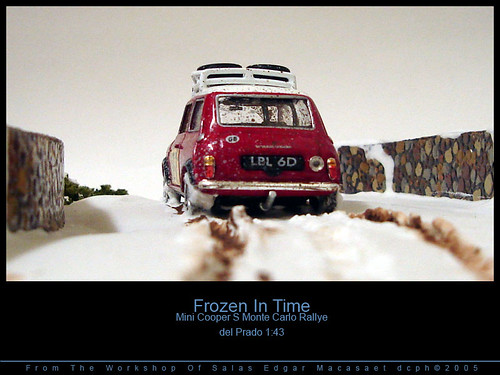so I opted to set decals and diorama building instead.
Although I can always sneak into a corner on the
ground floor of the building I live in, there’s always
a chance of being questioned about what the heck I am
doing spraying paint all over the place. I cannot risk it. :-(
So I opted for building scale models of structures and scenery instead.
I have been thinking of building another scale model
but was choosing between a car park entrance shroff’s
office with the guards and the entrance barriers and a racing scene.
Since I have Monte Carlo Rally Mini Coopers in 1:43,
I decided to do a racing scene of one of the Champions
bearing #177 instead :-)
I must admit, I have been looking for similar models
of the Mini Coopers, all 8 of them in the 1960s rally races,
but I can’t seem to find anymore than the #177 and #37.
And so on Friday night, I ventured off into the hobby shops
of HK and bought several materials and tools for my racing scene
project I eventually titled “Frozen In Time”
Bear with me for the next 30 minutes or so in going through the process.
Remember to put safety as your priority

Ingredients:
1. 1 pc.1:43 Mini Cooper Rally #177 ( by del Prado)
2. 1 pc. A2(42 cm x 29.7 cm) size Foam Board
3. 1 Sheet 20 cm x 40 cm Stone Wall
4. 1 pc. A4(29.7 cm x 21 cm) White Cardboard
5. Mr. Hobby Acrylic Paints(red, yellow, blue, black and white-basic colors)
6. #1,#2 and #5 Flat Paint Brushes, 1 of each
7. 2 Tumblers
8. 1 Rubber Cutting Mat
9. 1 UHU and 1 Elmer’s Glue
10. Pen and Paper
11. Steel Ruler
12. Cutter
13. Toothbrush
14. 150 g of Plaster Of Paris
15. 1 pc. A4(29.7 cm x 21 cm) Clear Hard Plastic Sheet
16. 1 pc. A4(29.7 cm x 21 cm) Light Blue Sponge-like Fabric
17. 1 pc. “Smoked” Plastic Folder
18. 1 pc. 33 cm by 24.5 cm Wooden Picture Frame
19. 1 18 cu. In.Bag of WOODLAND SCENICS Light Green Clump Foliage Bushes
20. 1 Flat Plastic Spatula
21. Water
22. A pair of Scissors
23. TAMIYA Masking Tape
24. 1 Ton of determination
Every scale model to be built needs a plan.
Get a paper and pen and start sketching what you
envision to be a road scene.
I opted for a bridge crossing where the barriers
are made of stone.
And of course, underneath the bridge lies a
narrow river or canal.
The Monte Carlo Rally was held during winter based
from the pictures that I got. The Mini Coopers in action
were more often than not, taken while traversing snow capped
roads and bushes and hills.

THE BRIDGE
Draw the outline of the bridge on the Stone Sheet and cut away.
In keeping up with your idea, always place
the cut away pieces on the plan every so often
so you won’t be venturing out from your original idea
but you may always change or adapt in the future.
Now, in order for your bridge to be “reliable and strong”,
it needs support. Remember you are doing a scale model
so card boards should be enough to play the role of steel members.
This bridge is 80 cm high from the ground
and about the same width (in 1:43 that should be
about 2 cms of your steel ruler)
The length is around 6 meters.(around 15 cms.)
Glue the pieces of card boards in equal distance
and about the right number (I chose 3 segments
in this model) on the under side of the bridge top
and wrap around with the remaining pieces of the
Stone Wall Sheet and place these on your sketch
with the model car for size comparison and overall
look assessment.

Mix 1 part Red, 1 part yellow, half part Black and White,
for a light olive/ beige base paint for your stone bridge.
Stones are natural materials and no one stone is equal
in the world like your fingerprint.
Mix several types of colors such as
sienna (1red, 1yellow 0.5 black 1 white),
umber (1red 1yellow and 1black),
grey (1 black and 1 white), etc (with an earth color concept)
And you will end up with a multi-colored shear wall bridge barrier.
Acrylic paints dry faster than enamel
or any oil based paints and are easy to manage.
Dilute small parts of water with the paints for
desired transparency.

I did the painting first so I may be able
to do the base of the diorama whilst the
paint is drying.
THE GROUND BASE
Measure the inside dimensions of your frame.
Get your FOAM BOARD and cut out the
rectangle out from it. Place the 2 sections
of the bridge on top and sketch the location
of the river/canal underneath it. Cut out
the river gap and make sure to cut up to
half of the width of the bridge in order to
define “a river running underneath” (see lower right image)
Why half?
If you cut all the way through,
you will not have a bridge but
a hole on the ground. Cutting only
the visible part of the river will
not require you to cut another piece
of board again for the bridge itself
where you will place the model car.

THE RIVER
The river will include the LIGHT BLUE SPONGE-LIKE FABRIC,
the SMOKED PLASTIC SHEET and the CLEAR HARD PLASTIC and GLUE
Place the cut out FOAM BOARD and mark the corners of the
visible river over the fabric.
This will be your boundary line for your glue application.
Cut out pieces of your plastic sheets to match
the size of the marked fabric but always go beyond
the area for glue application. This will be covered
by the FOAM BOARD anyway.
If you notice the several pieces of fabric
scattered all over the frame, this is done in order
for the FOAM BOARD to settle flatly on top.

THE RACE EFFECTS
You’re probably wondering why we need a
TOOTHBRUSH for this project.
Well, first an AIRBRUSH costs 500 HKD minimum
excluding the compressor which may run up to 2000 HKD.
So I opted for a toothbrush to
“spray” the race effects on the car.
Although an airbrush is much more efficient,
a toothbrush is a good alternative.
“Spraying” 2 colors of paint (sienna and white)
on the car will emulate the road conditions of the race.
Mix the colors for the sienna with more water than usual.
Cut out a “wiper” path from a strip of
TAMIYA MASKING TAPE and place over
the windows of the model car.
Dip in the toothbrush and flick the bristles
with your thumb (as shown) in the direction of the toy .
It may seem that the toy is bound for “destruction”
but that’s the effect we are looking for.
Well…not “total destruction”of course,
but just the right amount of wet soil and snow
covering the car.

While the racing effect is drying,
go back to work on the base of the diorama.
THE ROAD CONDITION EFFECTS
PLASTER OF PARIS is a white powder substance
that when mixed with water, it will coagulate into
a thick paste eventually drying into a hard but manageable
chalk like material. It may be chiseled and painted on.
The last time I’ve worked with the material was when
I was 13 years of age. :lol:
Fill a TUMBLER with water on its half level.
Pour in about 50 grams of PLASTER OF PARIS
and stir with the FLAT PLASTIC SPATULA .
Do this until the tumbler is filled up to the rim.
Remember, you have several minutes to spend before
the mixed plaster will harden so work with it carefully.
Pour onto your base foam board a little at a time .
You will notice that the plaster mixture does not spread
easily onto the surface because it is relatively heavier
with water. with your desired height, help the plaster
with your flat spatula and spread evenly on the board.
You are doing a natural snow scene
so the ground is uneven. It doesn't’t really matter
if you pour on a thicker amount on one part of
the base than in other areas.
Pour onto the bridge barriers as well for that snow-capped look.
On the river/canal banks, be extra careful
not to pour on the center of the plastic sheet
or you will lose the reflective area which is quite
important for a realistic look.
Let the plaster lay for about 5-10 minutes.
A thicker application means the plaster will dry
longer than a thinner one. This one has around
1 centimeter of plaster on it so it will harden
a bit faster. Work out all the details like the
BUSH FOLIAGE and the ROCKS
on the banks of the river.

THE BUSH FOLIAGE
The material is very soft and needs only the
drying plaster for it settle on its location.
You may fix the material on the plaster with ELMER’s GLUE.
Make sure to pour on the FOLIAGE a good amount of plaster
for the snow-capped effect which,
I must admit was very enjoyable to do.
Once you’re done with the FOLIAGE, your road scenery base
is 99 % done. The missing
1 per cent is the tyre tracks effect .

THE TYRE TRACKS
Your PLASTER must be drying well now.
In order to test the softness, prick the surface
with your spatula and if it goes through ,
then it is time for the finishing touch.
This is a critical moment as it can only be done once.
If you make a mistake-there isn’t any norm followed by the way-
you have to do the plaster application all over again.
Place your model car on the edge of the road
and once you have establish your desired position,
roll the car, pressing softly against the plaster,
forward until you’ve reached the position you want it to be.
I chose to stop rolling the car in the middle of the bridge.

FULL PICTORIAL








Thanks for your time :-)
No comments:
Post a Comment